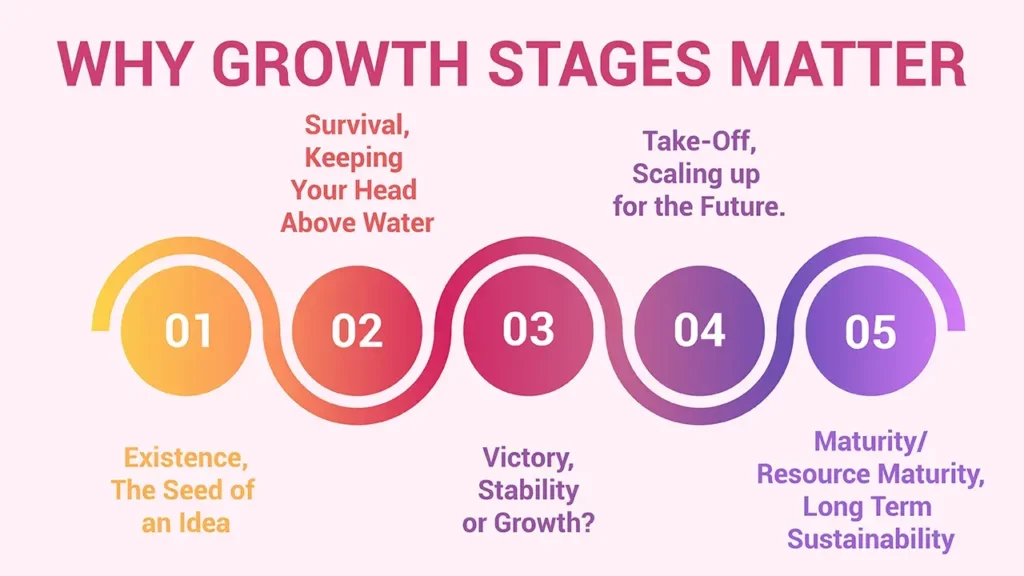Most small businesses move through certain predictable stages, from struggling startups to thriving enterprises. Knowing “the five stages of small business growth” is your ultimate guide.
This post will describe these three important phases so that you can recognize where your business is, predict what to expect, and plan for long-term growth.
Section 1: Why Growth Stages Matter

Growth Beyond Revenue: A Holistic Perspective of Growth
Growth is not all about sales; it’s about how you are built, what you do, and how long you can last. There are many advantages of understanding the small business growth stages:
- Pre-emptive Problem-Solving: Predicting problems before they turn into catastrophes.
- Resource management: Effective and efficient time, money, and talent use.
- Strategic Planning and Decision Making: Make decisions that are right for where you are.
- Be Realistic: Match your business’s goals with its capabilities.
- Don’t Fall into the Traps: Save yourself from making common mistakes from other retailers like you.
Understanding these stages helps in strategic foresight. For more on the importance of strategic planning, refer to ClearPoint Strategy’s article on the benefits of strategic planning.
Section 2: Stage 1, Existence – The Seed of an Idea
From Idea to Reality: Building up the Basics
Characteristics:
- The business is just starting or has recently launched.
- Concentrate on getting customers and providing the product/service.
- The owner is doing it all (sales, production, admin).
- Little of its own, typically self-financed or microloans.
- Cash flow is unpredictable; survival is the holy grail.
Key Challenges:
- Securing initial customers.
- Prove the product or service is viable.
- Managing cash flow.
- Owner burnout.
Success Factors:
- Strong product-market fit.
- Disciplined cash management.
- The commitment and flexibility of the owner.
Section 3: Stage 2, Survival – Keeping Your Head Above Water
Proving out the Viability: Achieve Repeated Revenue – Achieve Consistent Revenue
Characteristics:
- The small business model has been demonstrated to work; customers are coming in.
- Making enough money to support what you do.
- The focus changes to breaking even and positive cash flow.
- The owner is still very much involved in operational work daily.
- Lean team, often with “unofficial roles.”
Key Challenges:
- Greedily clinging to inconsistent profitability.
- Keeping up with growing operational demands.
- Managing sales and controlling expenses.
- Possible staff shortages as needs increase.
Success Factors:
- Efficient operations.
- Cost containment and financial responsibility.
- And how can a loyal customer base be built?
Section 4: Stage 3, Victory – Stability or Growth?
The Crossroads: Unity or Growth
Characteristics:
- Business is a stable, profitable business.
- The owner can delegate more, spending time on strategy.
- Good customer base and a strong cash flow.
- Decision point: Stay the same size (retaining success) or grow in size dramatically.
Key Challenges:
- Decision-making regarding expansion risks.
- Building strong management teams.
- Quality and quantity in growth.
- Getting money to grow.
Success Factors:
- Clear strategic vision.
- Good Financial Management and Planning.
- Assemble a strong Management Team.
- Effective delegation.
Section 5: Stage 4, Take-Off – Scaling up for the Future.
Hypergrowth: How to manage your many questions gathered from Unicorn leaders
Characteristics:
- Era of multiplying revenue and market share.
- Huge financial investment in equipment, technology, and personnel.
- Decentralized decision-making; bureaucratic structures take shape.
- All other daily work is done by the owner, who targets strategic planning.
- Good chance you’ll need outside financing (investors, bigger loans).
Key Challenges:
- How to scale and not lose its status or standards.
- Handling more red tape and complexity.
- Hiring and keeping the best-qualified employees in the competition.
- Safeguarding financing for expansion.
Success Factors:
- Strong management structures and processes.
- Leadership and purpose need to be stronger and focused.
- These companies can attract and assimilate new talent.
- Fiscal sobriety for growth.
Section 6: Stage 5, Maturity/Resource Maturity: Long Term Sustainability
Consistency. This is the Golden State Warriors, but with reinvention.n There are two ways to sustain excellence in the N.B.A.
One is to create a side that is among the very best and then build a system, both in terms of culture and on-court strategy, in which the parts have the best chance of humming, even if some of those parts come and go.
Characteristics:
- Big business that already has its resources and market position.
- Brand name recognition and a good customer base.
- Concentrate on operations, innovation and alliances.
- Formal organization and managerialism.
- May be challenged by entrants or new market dynamics.
Key Challenges:
- Ensuring the Continued Spirit of Entrepreneurship and Innovation.
- Preventing complacency.
- Responding to market changes and emerging technologies.
- Succession planning.
Success Factors:
- Perpetual invention and adjustment.
- Strong company culture and talent development.
- Above is strategic foresight and market insight.
- Effective risk management.
Conclusion: It’s a Never-Ending Journey for You
To summarize, an appreciation of the five “stages of small business growth” is confirmation that each stage of growth has its differences as well as its demands.
Understanding these stages can help business owners better plan their journey. Growth is not linear, and there may be times when companies need to return to earlier stages. It’s all about staying open to learning and being adaptable for the long run.
Call to Action
Check your progress and decide the next steps. Decide what it will take to advance on your business development path.
FAQs
1. What are the stages of small business growth?
The process consists of five stages, namely, Existence, Survival, Success, Take-Off, and Maturity/Resource Maturity.
Each phase is a different phase of business, with different challenges and opportunities.
2. Why is it important to know the phases of small business growth?
Recognizing these stages will enable entrepreneurs to predict the trials and tribulations they will be facing, allocate resources appropriately, and make smart decisions in building a strong plan for growth over the long term.
3. How is it possible for me to determine at which growth stage my business is?
You can score your business on a few of these factors, of course, business stage is not something that score should be derived from by itself, but with simplicity, size, complexity, and scale of revenue, success can serve as a surrogate for stage preference.
4. What is the primary challenge in the Survival phase?
The biggest challenge here is being able to generate consistent revenue, whilst bearing the cost of operating and sustaining the growing pressures of operations.

Leave a Reply